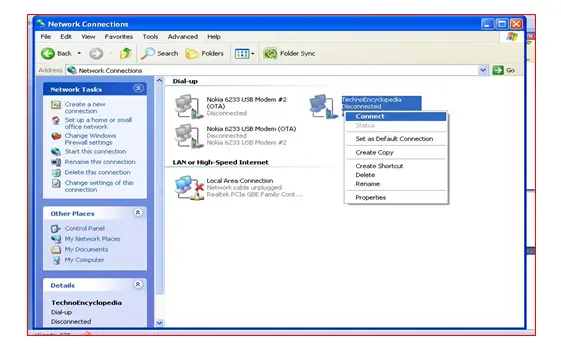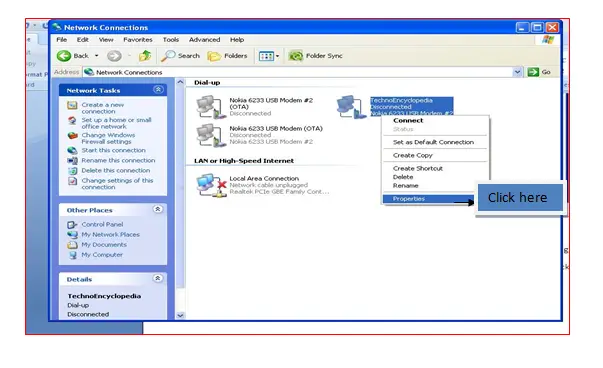A Detailed view of Dial Up Networking
- Dial up connection uses Public Switched Telephone network to access internet via telephone lines. It uses the modem to modulate and demodulate IP packets. In this, dial up connection sends signals through telephone lines.

- The advantages of Dial up connection are that its cost is low, full time availability as it requires only a telephone line, modem and provides security also; and the disadvantage is that its speed is slow as compared to others and while using the dial up connection, the phone line is busy.
- Dial-up connection is a kind of adhoc network which does not require any infrastructure. It only requires the existing telephone network. It uses the handshaking signal before communication takes place.
- Data transfer using the telephone, local loop was traditionally done using dial up modem. Modem is a device which provides functionality to modulate signal and demodulate signal. Most popular modem is on V series. First one is V.32 modem standard that uses a combine modulation and encoding technique called trellis coded modulation. Its data rate is 9600 kbps. Next is V.32 bits standard. It’s a first ITU-T standard to support 14,400 bps transmissions. Using this modem standard, you can adjust speed of modem upwards and downwards depending on the quality of line or signal. Next is V.34 bits modem that provides a bit rate of 28.000 with a 960 point constellation. V.90 modem has a data rate limitation of 33.6 kbps. However, it has a bit rate of 56,000 bps, so it is also known as 56K modem. V.92 modem can adjust speed and if noise is allowed, they can upload data at a rate of 48 kbps and downloading rate is 56 kbps. Modem has one additional feature that it can interrupt when there is an incoming call if the line has call waiting service.
- To get higher speed of internet, telephone lines have Digital Scriber line (DSL) technology. DSL has a set of technologies, each differentiated by a first letter like ADSL, VDSL, HDLS and SDSL.
- ADSL is an asymmetric communication technology designed for residential user. ADSL like 56K modem provides higher speed in the downstream direction than an upstream direction. ADSL uses the existing local loops. The exiting local loop can handle bandwidth up to 1.1. MHz. ADSL uses discrete multirole technique for modulation which combines QAM and FDM. Here each system can decide on its bandwidth division. Advance bandwidth of 1.104 MHz is divided into 245 channels and each channel uses a bandwidth of 4.312 kHz. ADSL modulates and demodulates data using DMT and creates downstream and upstream channel. After this, new technology was introduced which is ADSL lite. ADSL lite modem is to be plugged directly to the telephone jack and connected to the computer. Its advantage is that the connection is always on, it’s easy to use and reliable. ADSL needs to be standardized.
- Next DSL technology is HDSL (high bit rate subscriber line) was designed to substitute T-1 transmissions three or more times without the need of repeating. HDSL uses 2B1Q encoding which is less at risk to reduction. A data rate of 1.544 Mbps can be achieved through two transmissions up to a distance of 12,000 ft. HDSL uses two switched pair.
- SDSL (symmetric digital subscriber line) is one of the twisted pair versions of HDSL. SDLC gives equal bandwidth in both directions i.e. upstream and downstream. It allows a speed up to 1.5 Mbps with no additional hardware required. It’s best for residential subscribers who need to send mail, video chat etc. but not suitable for businessmen who send and receive large amount of data.
- VSDL (very high bit rate digital subscriber line) uses coaxial fiber optic or twisted pair for short distance. It provides a bitrate range of 25 to 55 Mbps for upstream communication at distance 3000 to 10,000 ft. The downstream rate is normally 3.2 Mbps.
- Generally dial up networking is not used nowadays as its speed is low but it provides security.
So anyone who wants high security can use it; or it can be used at a place where latest technology is not available.
How to setup a dialup network in windows XP:
Step 1) Go to start -> My network places -> click on view network connection -> select “Add new connection”. A new wizard opens as shown below.

Step 2) When this new wizard opens; click on next to set up dial up connection.

The above figure illustrates network connection types. There are four types.
Select the second option which is “Connect to the network at my work place”. And then click on next.
Step 3) After this new connection wizard opens, which shows two types of connections, select first one which is Dial Up connection. And click next.

Step 4) Now give a name to a connection. Here we have given “technoncyclopedia” as shown below figure. You can give any name which is appropriate to you and click next.

Step 5) After giving the name, give the name of Phone number. And click next.

Step 6) The figure below illustrates that you have created a dial up connection.

Click on finish.
Step 7) Now go to start -> My network places -> View network connections. Here you can see in figure below that technoncyclopedia dial up connection has been created.
Step 8) Now if you want to connect it, right click on selected dial up connection and select connect option to connect to the internet as illustrated in the figure.

Step 9) A new window will open, here give name and password and click on Dial to connect to the internet as shown in the figure below.

Now you can connect to the internet.
Step 10) If you want to check properties of your dial up connection which you created, again
go to My Network Connections. Select your connection which you created and right click on it and select properties option as shown in the figure below.

Step 11) Now properties window will open, showing the properties of your dial up connection, like this.

As you have seen in above figure, there are many tabs in properties window like general, options, security, networking, advanced. Check and change according to your requirements.
So in this article, I have shown you how to create a dial up connection in a Windows operating system.


















